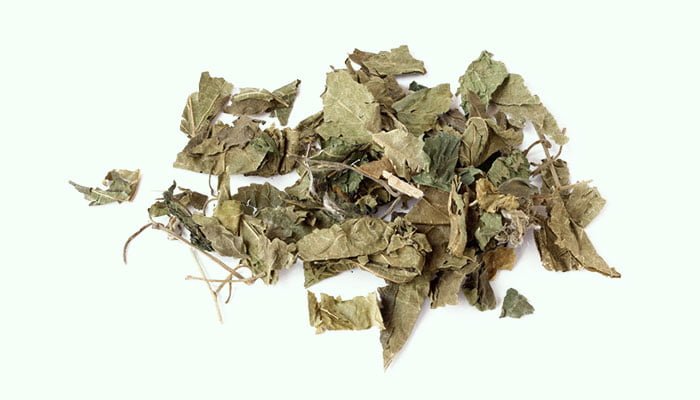What Is Sang Ye
Sang Ye commonly known as Mulberry Leaf or Folium Mori is the leaf of Morus alba L., which is a deciduous tree belonging to the family Moraceae. It is a commonly used Chinese herbal medicine, which first appeared in <Shennong Ben Cao Jing> in the late Western Han Dynasty (around 100 BCE).
There are 16 species of Mulberry, which are mainly distributed in the northern temperate zone. Such plants have certain economic value. Their leaves are the main feed for raising silkworms, and their fruits can be made into wine. Among them, Morus alba L. is the most representative.
Morus alba L. likes light and a warm and humid climate. It is native to central and northern China and is now distributed in China, North Korea, Japan, Mongolia, India, Vietnam, Russia, Central Asia, and Europe.

After the first frost of each year, people gather the leaves of Morus alba L., remove impurities, dry them in the sun, use them directly, or stir-fry them with honey, and make them into Chinese herbal medicines.
Sang Ye contain rutin, morusin, quercetin, isoquercitrin, naringenin, astragalin, resveratrol, β-sitosterol, stigmasterol, Campesterol, ecdysterone, polysaccharides, fatty acids, alkaloids, volatile oils, amino acids, vitamins, and some trace elements.
Generally, the fragile Sang Ye with the yellow-green or light yellow-brown upper surface is preferred.
According to the Chinese Pharmacopoeia, the medicinal nature of Sang Ye is relatively cold, with a sweet and bitter taste. It has a certain therapeutic effect on the pathological changes of the lung meridian and the liver meridians.
In traditional Chinese medicine, it is often used to dispel wind and heat, clear lung-heat and moisten dryness, stabilize liver Yang, clear liver and improve vision, and treat colds, dacryocystitis, stye, lung abscess, chyluria, brown spots, edema, elephantiasis of the lower limbs, brain atrophy, cough of larynx origin, suppurative otitis media, diabetes, early hypertension, obesity, angioneurotic headache, cerebral arteriosclerosis, seborrheic alopecia, alopecia areata, flat warts, and rheumatic arthralgia.
There are about 200 kinds of Chinese medicine prescriptions containing it, such as Sang Ju Yin, Sang Ma Wan, and Tianma Shouwu Pian.
Benefits
- Anti-inflammation, inhibiting croton oil-induced mouse ear swelling and carrageenan-induced mouse foot swelling.
- Anti-oxidation, scavenging DPPH free radicals, and superoxide anion free radicals.
- Inhibiting α-glycosidase activity, promoting insulin secretion, and reducing postprandial blood sugar levels.
- Reducing the content of total cholesterol, triglycerides, and low-density lipoprotein cholesterol in hyperlipidemia rats, and increasing the content of high-density lipoprotein cholesterol.
- Reducing liver damage induced by CCL4 and protecting the liver.
- Inhibiting the growth of liver cancer HepG2 cells and leukemia HL-60 cells, and inducing apoptosis of colon cancer HCT-15 cells.
- Dispelling wind and heat, treating fever, throat itching, and cough in the early stage of warm diseases or wind-heat.
- Clearing lung-heat and moistening dryness, treating a cough with less phlegm, yellow sticky phlegm, and itchy throat caused by lung heat or dryness-heat impairing lung.
- Stabilizing liver Yang and treating vertigo, headache, feel one’s head heavy and one’s feet light, and irritability caused by hyperactivity of liver-yang.
- Clearing liver heat, treating redness, swelling, and pian of the eyes, delacrimation caused by wind heat attacking the upper or flaming-up of the liver fire.
- Treating blurred vision caused by insufficiency of liver and kidney.
- Treating dizziness and headache caused by liver heat.
- Cooling blood to stop bleeding, treating hemoptysis, vomiting blood, and nose bleeding caused by blood heat.
- Its decoction has a certain inhibitory effect on Staphylococcus aureus, beta-hemolytic streptococcus, and Leptospira in vitro.
Combinations
- It can be used in combination with Ju Hua (Flos Chrysanthemi), Lian Qiao (Fructus Forsythiae), Bo He (Mentha), Jie Geng (Radix Platycodi), etc. to treat fever, throat itching, and cough in the early stage of warm diseases or wind-heat.
- It can be used in combination with Xing Ren (Semen Armeniacae), Nan Sha Shen (Radix Adenophorae), Chuan Bei Mu (Fritillaria Cirrhosa), etc. to treat a cough with less phlegm, yellow sticky phlegm, and itchy throat caused by lung heat or dryness-heat impairing lung.
- It can be used in combination with Ju Hua (Flos Chrysanthemi), Shi Jue Ming (Concha Haliotidis), Bai Shao (White Peony Root), etc. to treat vertigo, headache, feel one’s head heavy and one’s feet light, and irritability caused by hyperactivity of liver-yang.
- It can be used in combination with Ju Hua (Flos Chrysanthemi), Chan Tui (Periostracum Cicadae), Xia Ku Cao (Spica Prunellae), Jue Ming Zi (Cassia Seed), etc. to treat redness, swelling, and pian of the eyes, delacrimation caused by wind heat attacking the upper or flaming-up of the liver fire.
- It can be used in combination with He Shou Wu (Fo-Ti), Shu Di Huang (Processed Rehmannia Root), Huang Jing (Rhizoma Polygonati), Dang Gui (Radix Angelicae Sinensis), Tian Ma (Rhizoma Gastrodiae), Mo Han Lian (Eclipta prostrata), etc. to treat dizziness, headache, tinnitus, painful mouth, dry mouth, soreness of waist and knees, gray hair and hair loss caused by deficiency of liver-yin and kidney-yin.
Side Effects
- Animal experiments have shown that high-dose use of Sang Ye may cause degeneration and hemorrhagic damage to animal lungs, liver, and kidneys.
Precautions and Warnings
- The dosage of Sang Ye should be controlled at 5-9g.
- It can be made into decoctions, pills, powders, or ground for external application.
- People who are allergic to Sang Ye should not take it.
- Pregnant women and breastfeeding women should take it under the guidance of a doctor.
- Children, the elderly, and the infirm should take it under the guidance of a doctor.
- Stir-fried Sang Ye with honey is often used to moisturize the lungs and relieve coughs.
